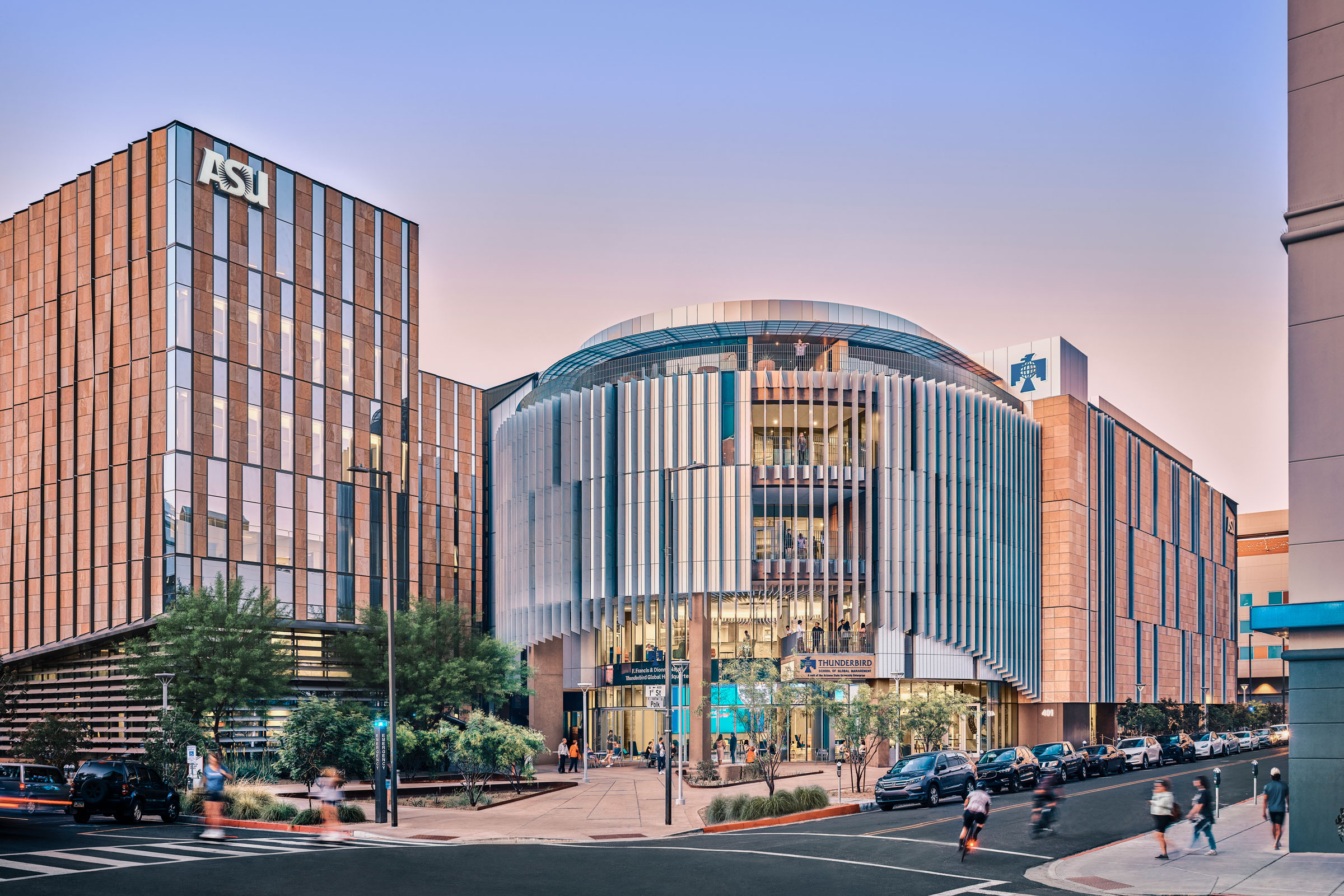Story at a glance:
- LEDs are considered to be the most energy-efficient lighting solution on the market and regularly outperform incandescent and fluorescent lights.
- The energy-efficiency of lighting systems can be improved by replacing old bulbs with LEDs, upgrading existing fixtures, and installing better lighting controls.
- American Lighting, Tivoli Lighting, and Energy Focus are three well-respected companies offering energy-efficient lighting solutions.
Electric lighting is without a doubt one of the most significant inventions of the last 250 years and has fundamentally changed the way humans work, live, and interact with the world. That said, until very recently how we illuminate the built environment has been largely inefficient. Over the last few decades energy-efficient lighting technology has advanced significantly, giving us the ability to light our world better than ever before while using less energy.
Let’s take a look at the types of energy-efficient lighting, their benefits and disadvantages, and strategies for improving lighting energy efficiency. Some lighting upgrades can even contribute to tax credits.
What is Energy-Efficient Lighting?
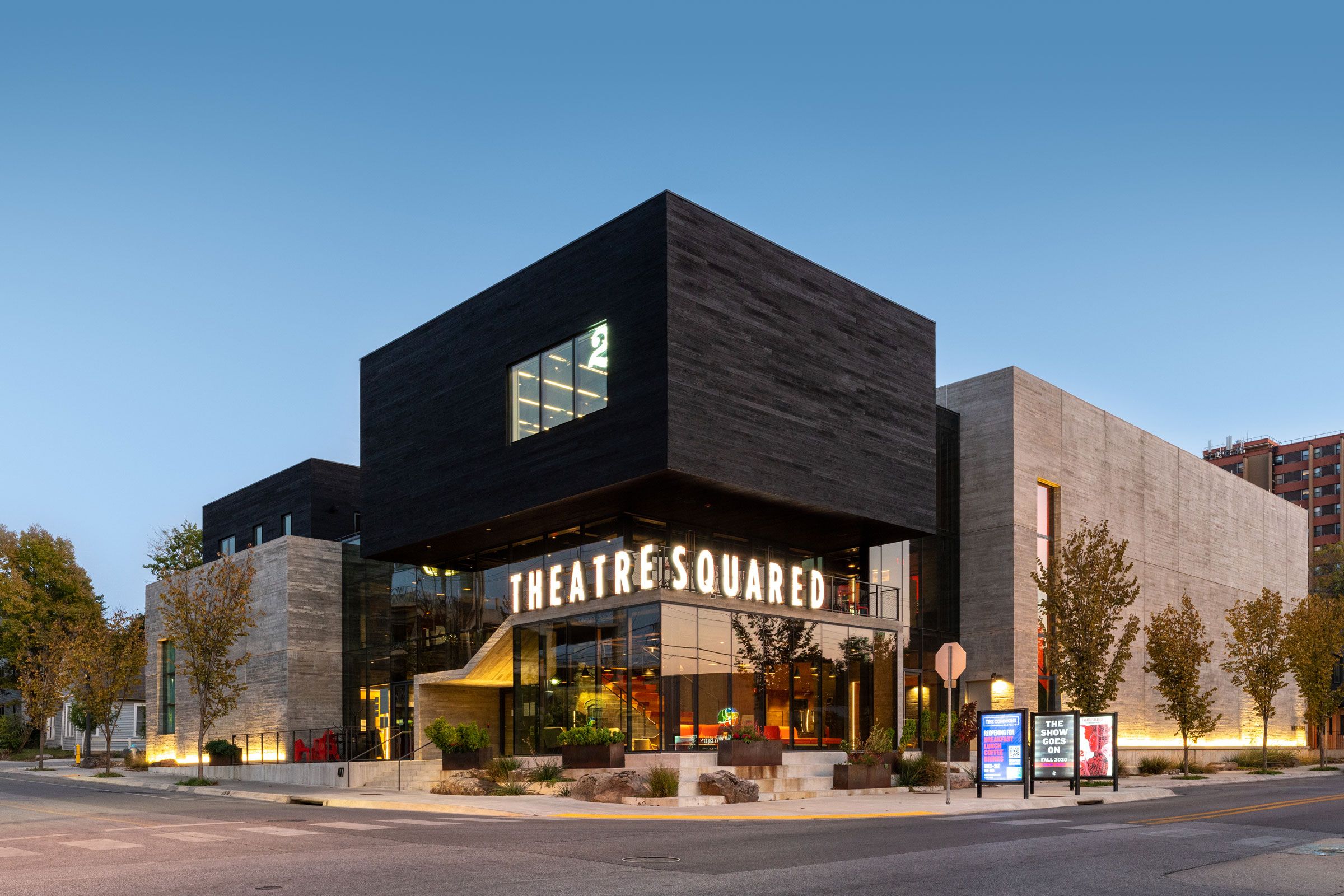
The TheatreSquared project is lit exclusively with energy-efficient LEDs. Photo by Kristian Alveo
In the fundamental sense energy-efficient lighting refers to those lighting solutions intentionally designed to use less energy than conventional lighting systems (conventional in this case referring to incandescent light-bulbs). True energy-efficient lighting solutions will bear an ENERGY STAR label to indicate they have met the rigorous energy-use requirements and criteria set by the EPA and DOE.
In the built environment energy-efficient lighting generally only encompasses artificial lighting sources and is considered distinct from daylighting, or the practice of using natural light to illuminate an interior space (though the two strategies are often used alongside one another).
Why is Energy-Efficient Lighting Important?
Artificial lighting is, like it or not, a necessity in our modern world, and all buildings require some amount of light to function. On average lighting accounts for 15% of the world’s annual energy consumption and produces 5% of worldwide greenhouse gas emissions (GHG), according to the DOE.
Considering that GHGs are the number one contributor to anthropogenic climate change, any reduction in emissions is considered beneficial. Replacing existing lighting systems with energy-efficient alternatives is one of the easiest ways to reduce emissions from the built environment.
Types of Energy-Efficient Lighting
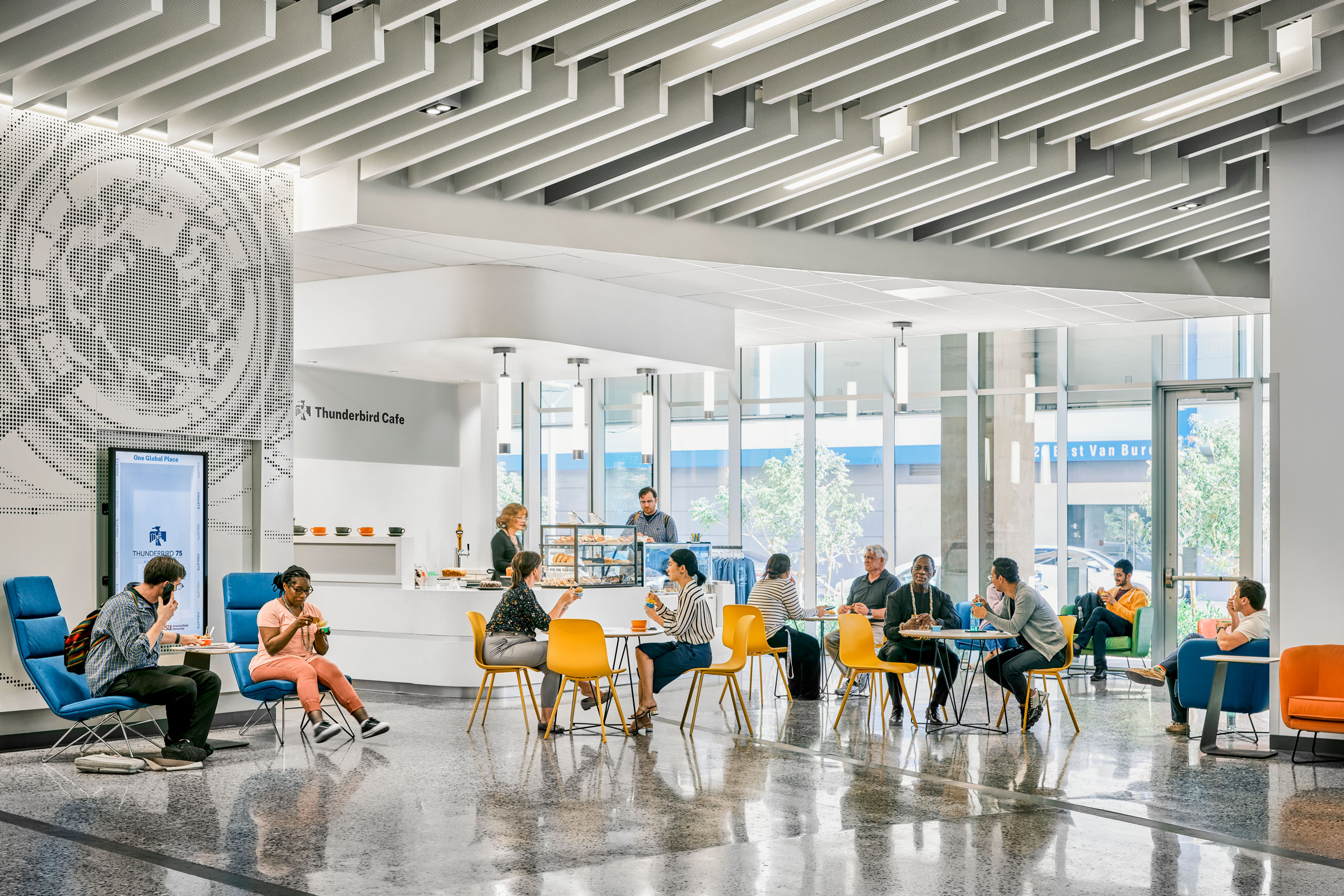
All of the lighting installed in the Thunderbird Global Headquarters uses LED sources. Acoustic baffles by Ceilings Plus in Barz Lumin White and Standard Silver. Photo by Inessa Binenbaum
Currently there are three main types of energy-efficient lighting solutions: compact fluorescent light-bulbs (CFLs), linear fluorescents, and LEDs. These are all considered to be energy-efficient when compared to the traditional incandescent light-bulb, though LEDs significantly outperform both types of fluorescent bulbs.
Halogen light bulbs were considered slightly more efficient than incandescents, but the DOE recently changed light bulb minimum efficiency standards so the manufacture and sale of halogen bulbs, along with incandescents, was banned as of 2023.
Compact Fluorescent
CFLs are a type of energy-saving lighting solution that rely on gas reactions to produce visible light. CFLs feature a folded tube that contains a mixture of both argon and mercury vapor; the inside of this tube is coated with a thin layer of fluorescent paint. When the light is switched on, the CFL’s internal ballast system sends an electric current through the tube in order to excite the gasses and produce ultraviolet light. The coating of fluorescent paint serves to then absorb those UV rays and emit visible light through the tube’s glass envelope.
CFLs are considered to be relatively efficient as they use 70% less energy and produce 70% less heat than incandescents do. CFLs have an average lifespan of 10,000 to 15,000 hours, significantly outperforming the 1,000 hour rating of most incandescent bulbs (though they pale in comparison to LEDs). Similar to halogen light-bulbs, however, CFLs are set to be banned—and have already been banned in some states—as a result of changing minimum efficiency standards.
Linear Fluorescent
Linear fluorescent bulbs are functionally identical to CFLs and differ only in terms of shape; instead of the traditional oblong bulb or twisted-tube shape, linear fluorescent lights take the form of long tubes. Linear fluorescent lights use the same amount of energy as CFLs but have a much more variable lifespan ranging anywhere from 6,000 to 60,000 hours. This variability is largely due to their manufacturing, operating conditions, and the type of control circuit they use.
Like CFLs some linear fluorescent bulbs are in the process of being banned in certain states, namely Vermont and California.
LEDs
Unlike fluorescent lights, LEDs do not produce light by way of electrical activation of gasses. Instead, electricity passes through a semiconductor device that illuminates a diode to produce visible light. LEDs are the most energy-efficient option on the market and consistently outperform halogen, incandescent, and fluorescent light fixtures. Most LEDs use up to 90% less energy than traditional incandescent lights and produce almost no heat whatsoever.
LEDs are available in a range of fixtures and configurations, including:
- Standard. Describes the conventional bulb shape capable of dispersing light throughout a room; typically used in lamps, semi-flush, and flush-mount fixtures.
- Can Light. Light bulbs that fit into sockets or “cans” mounted in the ceiling; sometimes referred to as recessed lights.
- Linear. Long LED light tubes that function similarly to linear fluorescent bulbs; often installed overhead to illuminate workspaces like those in a kitchen or office.
- Track Bulbs. Individual light fixtures that may be slid along a track and adjusted to the desired angle or position; generally used to provide directional light, as task lighting, or to illuminate a specific feature, such as artwork, on a wall.
- Flood. Designed to emit a wide, strong beam of light in order to illuminate a large area; typically used in an outdoor setting.
- Light Strips. Flexible strips of LEDs that may be cut to length and applied just about anywhere; often used underneath shelves and cabinets.
What to Know When Choosing Energy-Efficient Lighting
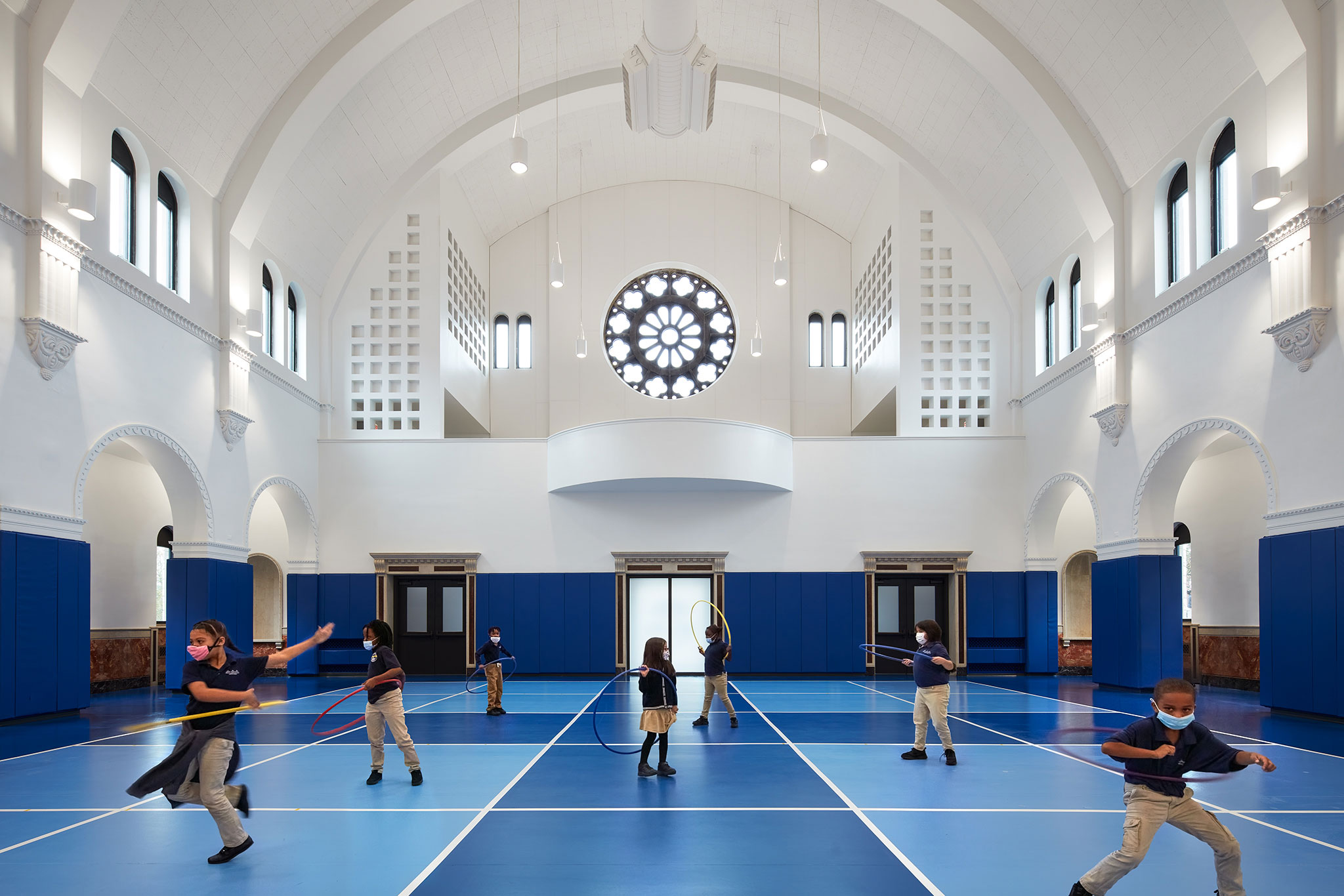
The Great Lakes Academy employs high-performance LED direct-indirect pendant fixtures throughout the gym and plentiful windows give an abundance of natural lighting within the volume. Photo by Kendall McCaugherty, Hall + Merrick Photographers
When it comes to choosing energy-efficient LED lighting for your project, there are a few important factors to consider:
- Lumens. Refers to the quantity of light produced and replaces the wattage measurement used by incandescent light-bulbs and CLFs; the higher the lumens, the brighter the light will be (some, but not all, LEDs are dimmer compatible and thus have a sliding lumen scale rather than a fixed number).
- Color Temperature. The color temperature of LEDs is measured via the Kelvin scale; LEDs that range between 2,700 and 3,000 Kelvin emit a warmer, “soft white” light reminiscent of old-school incandescents, whereas LEDs in the 5,000+ Kelvin range emit a cool light that is slightly blue (some LEDs are adjustable and are capable of producing both warm and cool light).
- Color Rendering Index (CRI). The quantitative measurement (between 0 to 100) of a light source’s ability to accurately reveal the color of an object as compared to natural lighting; the higher the CRI, the more faithful the color rendering.
- ENERGY STAR rating. While there are many LED lighting options, not all of them are considered high-quality; if you want to make sure your energy-efficient lighting solution won’t flicker and is an all around quality product, choose one that bears an ENERGY STAR label.
As a general rule it’s never a good idea to install or replace a building’s light fixtures/bulbs all at once without checking to make sure that the lighting solution you choose actually works well with the environment. Test a few different options to ensure that the lighting isn’t too bright, too warm or too cold, and depicts colors as desired.
Benefits of Energy-Efficient Lighting
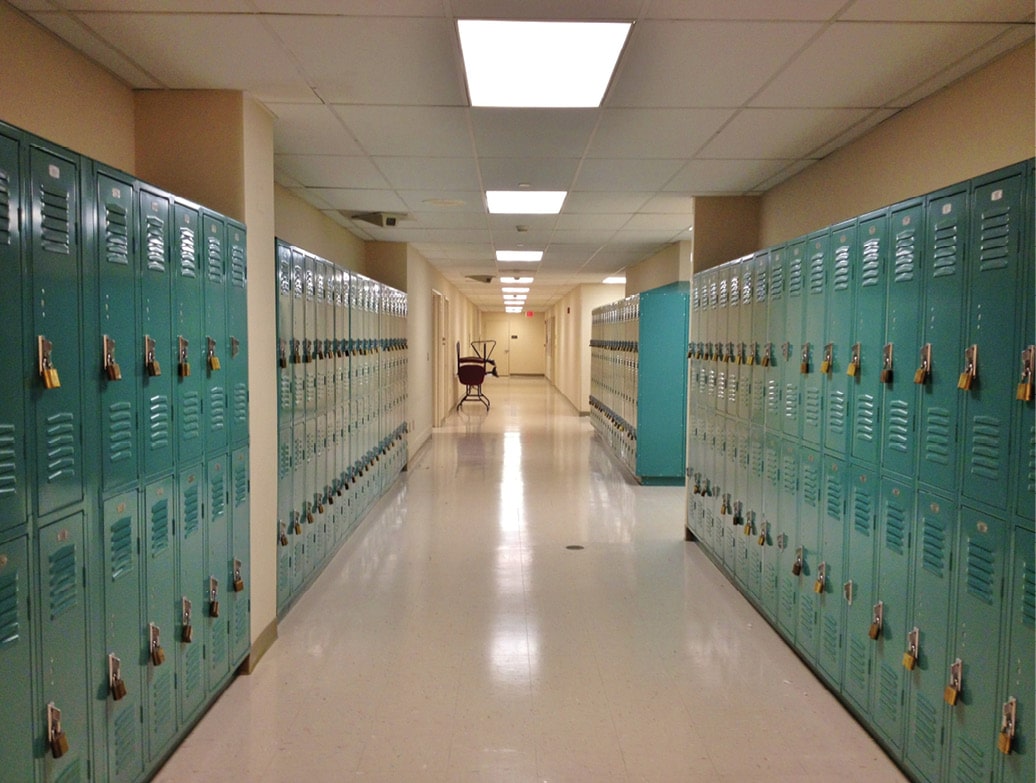
The brightness and long life of LED lights make them a great option for emergency lighting. Photo courtesy of Fulham
While the most beneficial aspect of energy-efficient lighting is in the name, they offer several other benefits as well, including:
Reduced Operating Costs & Carbon Emissions
On average LED lights use up to 90% less energy than standard incandescent or fluorescent bulbs, according to the DOE. As a result facilities that make use of LED light fixtures have lower operating costs and produce fewer carbon emissions compared to those without energy-efficient lighting solutions.
Longevity
Due to their lack of filament (the part that burns out in incandescent bulbs) and high-voltage electrical parts (the parts that typically fail in the case of fluorescents), as well as their use of epoxy resin over glass, LED lights are much more durable than traditional light bulbs while also possessing a much longer shelf life.
On average LEDs have an operational lifespan of 50,000 to 100,000 hours, or between 10 and 20 years depending on the frequency of use. This lifespan is nearly 25 times longer than conventional incandescent bulbs and four times longer than most CFLs.
Versatile
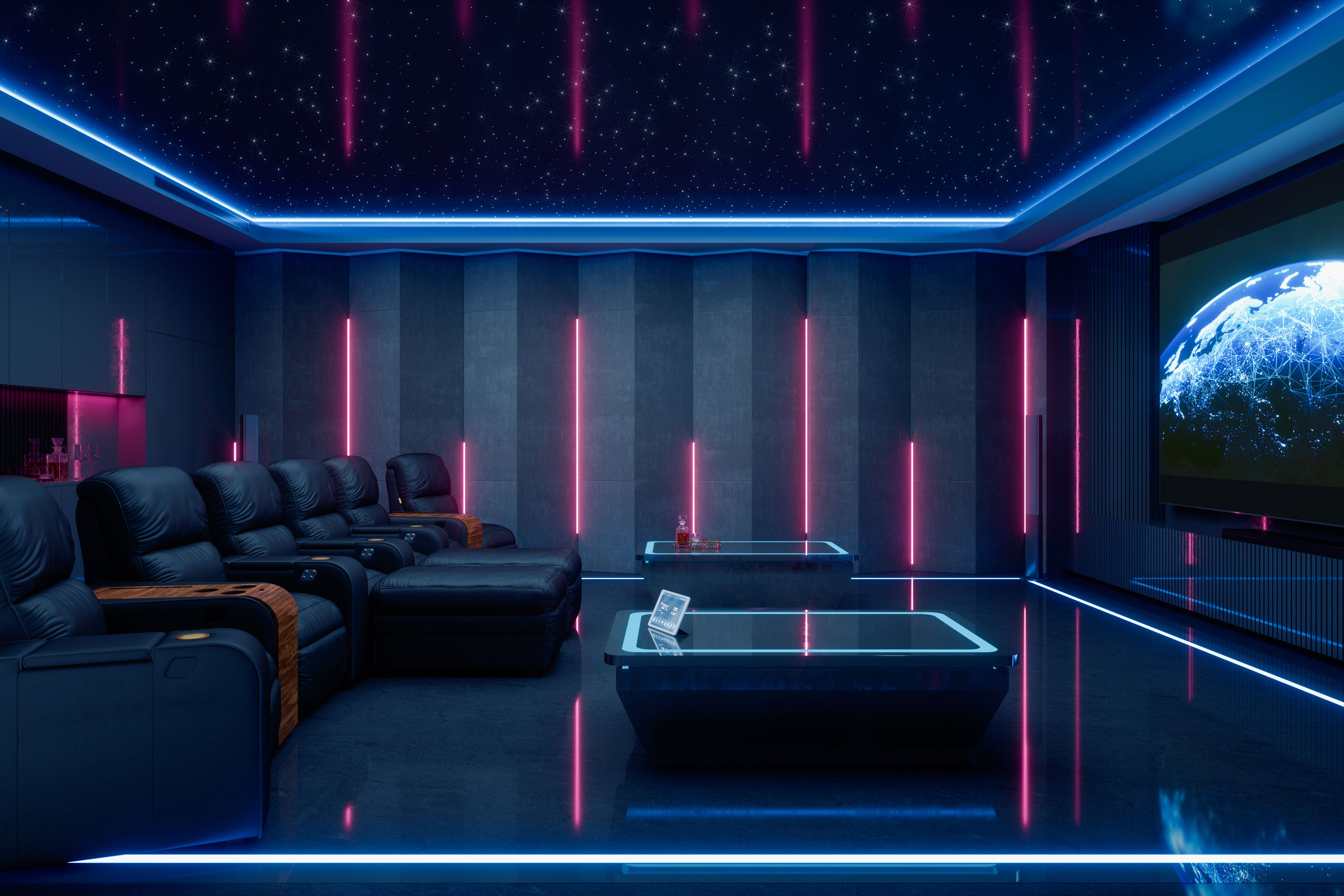
Photo courtesy of American Lighting
Energy-efficient LED lighting is incredibly versatile and has a wide range of potential applications within a diverse array of facilities. Linear strip or tape lights are especially adaptable and may be installed just about anywhere you can think of. Most modern LEDs also support a range of colors as well as true white light, allowing for highly customizable lighting solutions.
“With RGBTW consumers virtually have an unlimited RGB palette of color combinations along with the ability to adjust true white light ranging from 2700K up to 6000K,” Jennifer Kirkpatrick, director of sales at American Lighting, previously wrote for gb&dPRO. “The intense color saturation, transition effects, and fade to white lighting effects deliver limitless color combinations with a 50,000 hours performance life.”
Health & Productivity
Energy-efficient LEDs can also help improve mood and occupant productivity as they are able to better simulate natural sunlight compared to fluorescent and incandescent lights. Regular exposure to sunlight is known to improve mood and reduce stress. In fact, it’s crucial to our health and well-being. “Light is a stimulant of our biological system that drives physiological change, constantly signaling to our bodies when to produce chemicals, initiate functions, and even clean our brains of the day’s plaque,” Kirkpatrick writes.
Because they come in a wide variety of colors, wavelengths, and lighting temperatures, LED lights offer a more sophisticated level of control that allows them to mimic the circadian impact and psychological effect of natural light better than incandescent and fluorescent bulbs (when implemented correctly, that is).
No Strike Delay
Unlike fluorescent or incandescent lights LED light fixtures have no strike delay. This means that as soon as the switch is flipped LED lights will turn on to full brightness rather than gradually getting brighter over time. While not the most impressive of advantages, this lack of strike delay is still a convenient quality that makes LEDs incredibly useful in environments that may be unsafe in momentarily low-lit conditions.
Disadvantages of Energy-Efficient Lighting
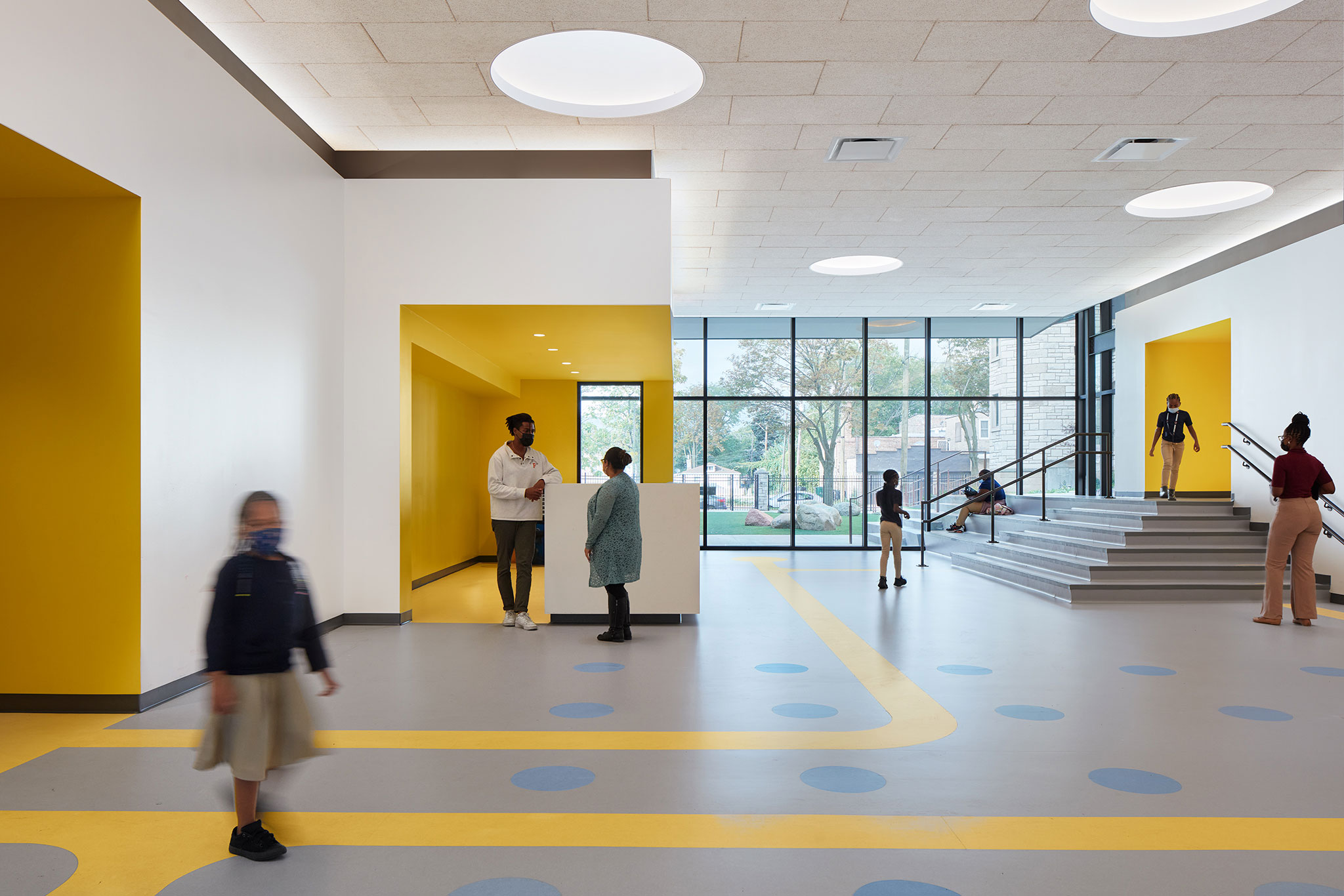
Despite their higher upfront costs, the LED lights in this renovated charter school were chosen for their long-term efficiency and cost effectiveness. Photo by Kendall McCaugherty, Hall + Merrick Photographers
There’s no denying that energy-efficient LED lighting solutions have a range of desirable benefits—but that’s not to say they are completely without flaws either. Some of these disadvantages include:
Higher Upfront Costs
One of the major disadvantages associated with energy-efficient LED lighting is the higher upfront cost. Even though they’ve become considerably less expensive than they used to be, LED lights and fixtures still tend to have a higher price tag compared to their incandescent and fluorescent counterparts. A six-pack of standard LED light bulbs, for instance, might cost around $28 to $30, whereas a six-pack of CFLs typically only costs between $22 and $25.
Despite these higher upfront costs LEDs are still the most cost-effective energy-efficient lighting solution in the long term.
Contain Heavy Metals
While LEDs do not contain mercury like CFLs do, they still contain a variety of heavy metals including lead, arsenic, and antimony. If an LED breaks or isn’t properly recycled at the end of its operational lifespan, these heavy metals may be released into the environment and pollute the water and soil.
Susceptible to Overheating
Though LEDs do not produce a significant amount of heat themselves, they are susceptible to overheating from outside forces and therefore require more air circulation than other lighting solutions. Overheating can result in thermal damage to the LEDs circuit boards and solder joints, leading to premature failure and a drastically reduced lifespan.
Can Disrupt Circadian Rhythm
When implemented correctly using the right color temperature LEDs are great at mimicking the natural sunlight required to maintain our bodies’ circadian rhythm—but they can also disrupt sleep patterns if implemented incorrectly. This is largely because most LEDs produce a bluer light than traditional incandescent bulbs.
This blue range of light is great for stimulating alertness and productivity, but can negatively affect the body’s ability to fall asleep. For this reason, LED lights with a very cool color temperature should only be installed in spaces frequently used during daytime hours (e.g. office spaces, classrooms, commercial buildings, etc.). LEDs installed in bedrooms and sleeping areas, on the other hand, should possess a lower color temperature that emits less blue light to avoid disrupting the body’s circadian rhythm.
How to Implement & Improve Lighting Energy Efficiency
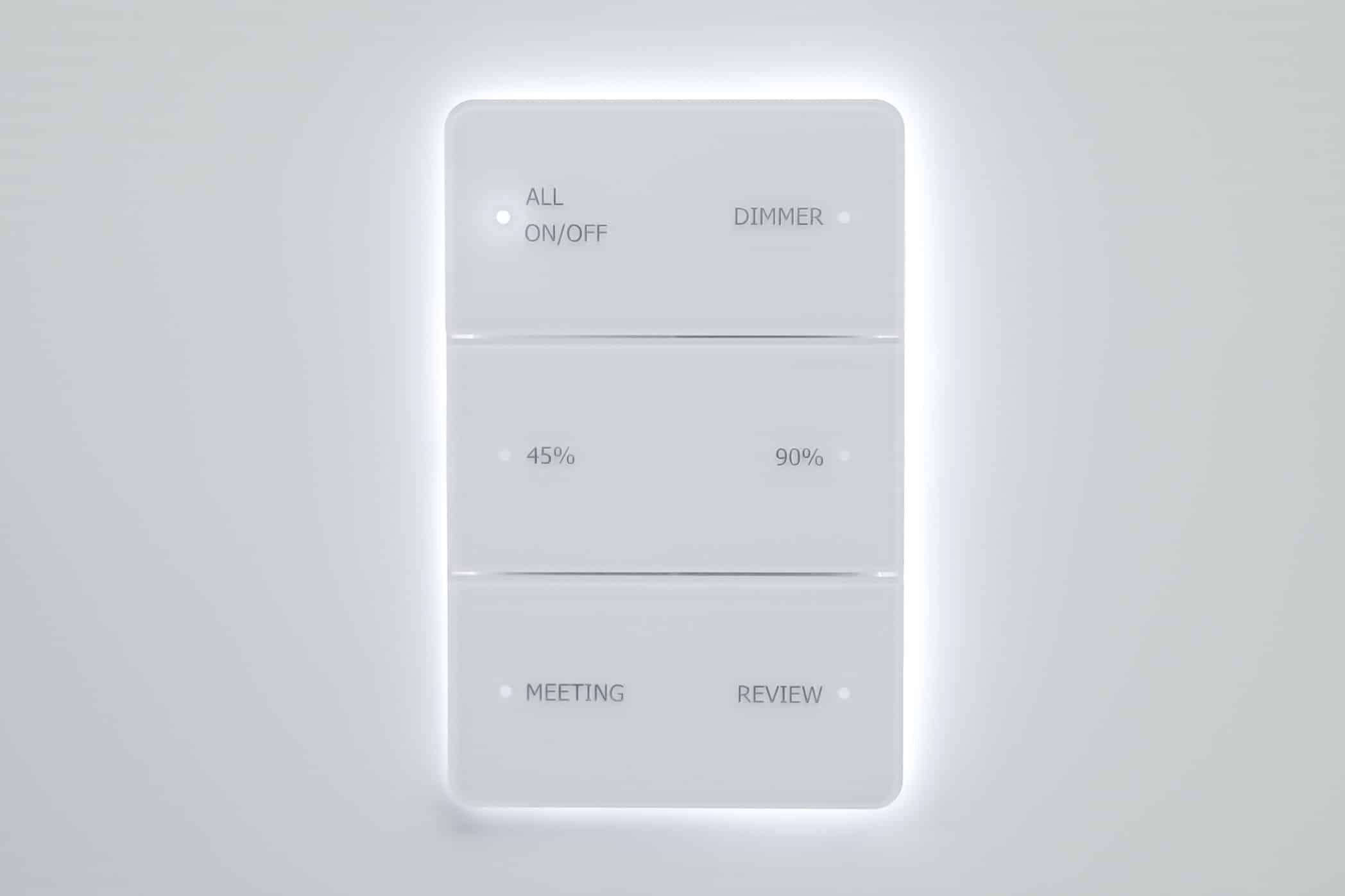
Customizable controls like these capacitive touch keypads allow comprehensive lighting programming while still enabling occupants to override controls and adjust the lighting in their space. Photo courtesy of lumenomics
While the use of LEDs that bear an ENERGY STAR certification is the most effective way to improve lighting energy efficiency, there are a few other factors that can also contribute to increased energy savings.
Replace Old Bulbs
If your building or home is still using incandescent, fluorescent, or halogen bulbs, it is highly recommended that you replace them as soon as possible with ENERGY STAR–certified LED bulbs. This is the least intensive way to reduce a building’s lighting-related energy consumption.
Install New Fixtures & Ballasts
Lighting efficiency can be improved further by replacing existing fixtures, ballasts, and accessories with new ones. This is because some light fixtures actually absorb a large percentage—sometimes more than half—of light emitted by the bulb, effectively wasting that energy and reducing the bulb’s overall ability to illuminate a space properly. Energy-efficient fixtures typically feature reflectors that help redirect light in the desired direction.
Another common area associated with energy loss is a light fixture’s ballast, a type of electrical resistor that is fixed in-line with the circuitry that supplies mains power to the bulb itself. LED bulbs do not actually require a ballast, but many are designed to be ballast-compatible for the sake of retrofit convenience. Conventional ballasts rely on magnetism and can cause power losses equating to 15% of the bulb’s total wattage. Replacing these magnetic ballasts with solid state or electronic ballasts can reduce energy consumption by 20 to 30%.
Improve Lighting Controls
Installing better lighting controls, such as sensors, timers, and dimmer switches, can also help improve the overall efficiency of LED lighting solutions. Devices like motion, daylight, and even thermal sensors can detect certain environmental conditions to ensure lights are only activated when they are absolutely necessary (e.g. the lights in a room turn on after the sun has started to set and a person walks in).
Timers, while less sophisticated, can also improve lighting control and reduce energy consumption by ensuring that lights only come on at certain times of the day/night instead of remaining illuminated at all hours.
Dimmer switches, on the other hand, provide occupants with greater control over lighting intensity while also reducing the flow of electricity to the bulb itself. Restricting the flow of electricity allows lights to operate with a lower power output and can result in significant energy savings.
Keep in mind that not all LEDs are dimmable and even those that are typically aren’t compatible with older dimmer switches designed for incandescent or halogen bulbs. If you want to be able to dim your LEDs make sure they are labeled “dimmable” in their product description and take care to install switches designed to work with LED technology, such as those offered by lumenomics.
Building Automation Systems
LED lighting solutions can be made even more energy efficient when they are connected to and controlled by a building automation system (BAS), as these systems offer improved adjustability when it comes to energy-efficient lighting solutions. This is especially true of BAS capable of being controlled via an app, smartphone, or tablet; these types of controls often allow occupants within the building to fine-tune and adjust the lighting in an office or meeting room to suit their individual preferences.
Clean-Energy Integration
LED lighting can also be made more energy-efficient if powered by clean energy; this includes both conventional lighting solutions that have been linked to a renewable energy grid and lighting systems that have been designed specifically with clean energy in mind.
Some lighting manufacturers, for example, offer exterior and interior LED lighting solutions that are powered by their own independent solar panels rather than electricity derived from the burning of fossil fuels. These lighting strategies are often considered the pinnacle of energy efficiency and are ideal for use in buildings that are off-the-grid or as emergency light sources during power outages.
Tax Benefits for Energy-Efficient Lighting
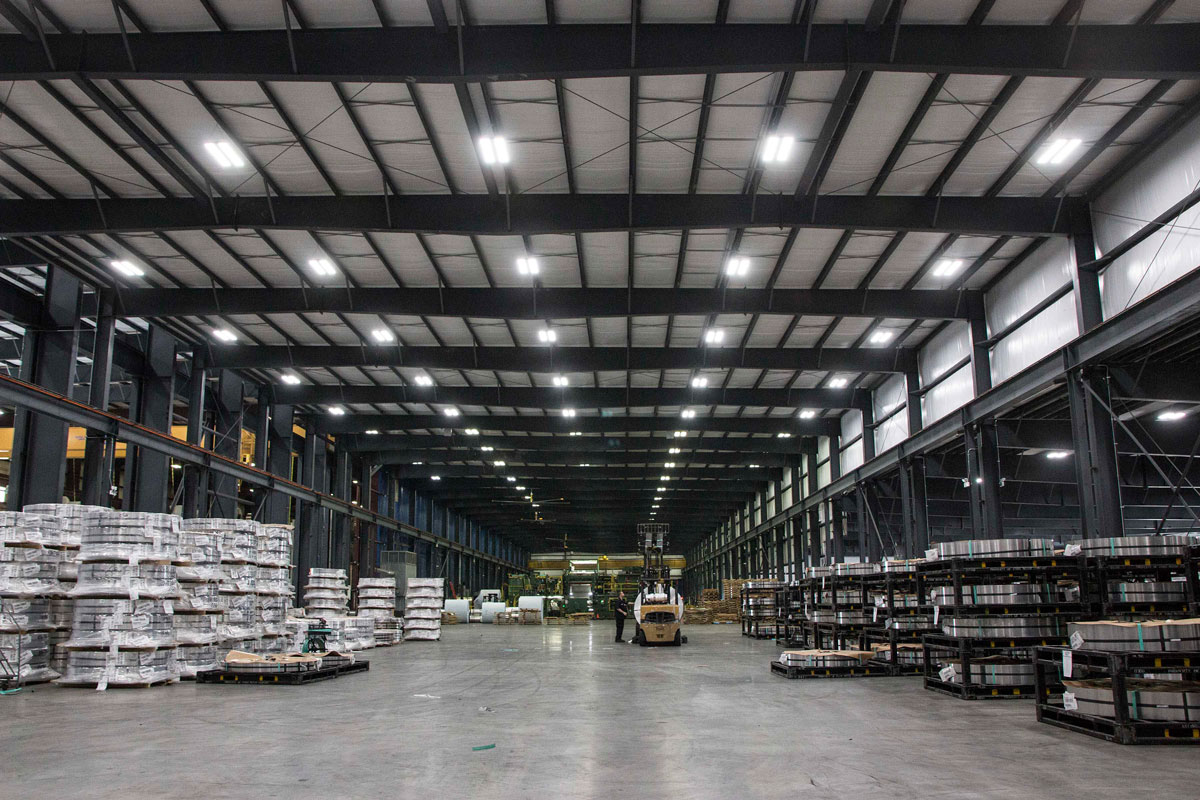
Energy-efficient LEDs can help commercial buildings like this warehouse qualify for energy-related tax credits. Photo courtesy of Future Energy Group
While there aren’t any tax benefits or incentives designed specifically for energy-efficient lights, installing energy-efficient lighting alongside other appliances and products can help buildings qualify for certain energy-efficient tax benefits.
Commercial Buildings
Energy-efficient lighting can help commercial buildings—a designation that typically includes warehouses, retail buildings, libraries, apartment buildings with 4+ floors, office buildings, government-owned buildings, parking garages, industrial buildings, and public universities—qualify for the following tax deductions and benefits:
- Section 179D. A partial tax credit that falls under the Energy Efficient Commercial Buildings Deduction and may be applied to lighting upgrades dating as far back as 2006; allows projects that have reduced their exterior/interior lighting energy usage by at least 25% to deduct $0.60 to $0.63 per square foot of lighting.
- QIP 100% Bonus Depreciation & Sec. 179. LED lighting that has been installed in non-residential buildings after the building has been in service may qualify for an immediate write-off using 100% bonus depreciation or Section 179; allows a company to immediately deduct the full cost of eligible investments instead of spreading the deduction over multiple years.
- Asset Retirement. Refers to the process of disposing an old asset (e.g. replacing outdated lighting with energy-efficient LEDs) off the books and taking a write-off for the remaining basis.
Note that you should always consult with a CPA or other tax professional to find out whether your business or property qualifies for these tax benefits, as every tax situation is unique.
Homes
Energy-efficient lighting improvements currently do not count toward the Energy Efficient Home Improvement Credit or any other energy-related credits available to homeowners. A full breakdown of what energy-efficiency improvements and upgrades are covered under this credit may be viewed on the IRS’ website.
If your home includes lighting solutions powered by solar or some other form of renewable energy you may be eligible for the Residential Clean Energy Credit. In this case, however, it is the equipment that generates and stores the electricity that qualifies for the credit, rather than the lighting systems themselves.
Consult with a licensed tax professional if you have questions about energy-efficient lighting upgrades and how they relate to possible tax credits or deductions.
Energy-Efficient Lighting Examples
As the market becomes increasingly saturated by LEDs and energy-efficient lighting options it can be difficult to figure out which companies and manufacturers offer the best lighting solutions. The following section highlights three companies—American Lighting, Energy Focus, and Tivoli Lighting—that have become respected in the field when it comes to energy-efficient lighting strategies and products.
American Lighting
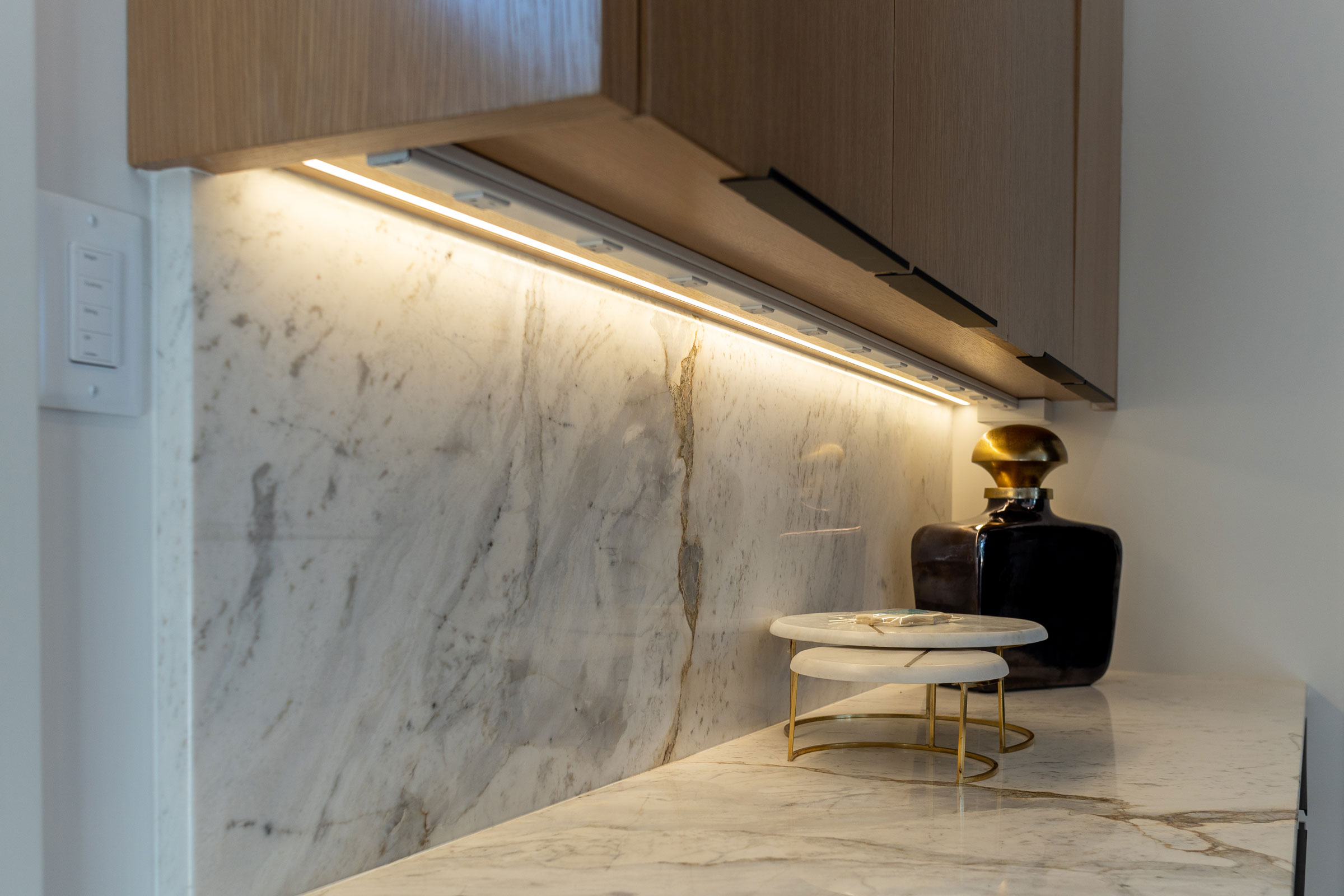
The kitchen and bar cabinets are modified with 3000K COB Tape Light Universal Extrusions. Photo courtesy of American Lighting
Founded in 1989, American Lighting is a leading manufacturer of high-quality, energy-efficient lighting solutions suitable for commercial, residential, and specialty projects. Their products may be found in buildings across the country and are often implemented in innovative, creative ways—indeed, one luxury lake-house in Lake Winnebago, Missouri is outfitted almost exclusively with American Lighting products.
American Lighting’s 3000K COB tape lighting, for instance, is a versatile, energy-efficient LED light solution that features uniform illumination and eliminates the dotting often associated with LED strip lights. “The tape light’s output ranges from 349 lumens to 460 lumens per foot and is cuttable every 1.97” with 16.4-foot maximum run for custom applications,” writes Kirkpatrick. “In addition, the tape lights have the flexibility to adjust color temps from 2700K to 6000K, creating millions of color possibilities with greater brightness and overall color saturation to create elegant lighting that caters to different times of the day or various applications.”
Energy Focus
Based in Ohio, Energy Focus is one of the leading companies pioneering development in the field of energy-efficient LED technology; they offer an extensive suite of LED lighting products, are a Green Apple Partner with the USGBC’s Center for Green Schools, and routinely provide academic and health care facilities with innovative lighting solutions.
Intellitube, for example, is a linear LED tube produced by Energy Focus that offers a wide range of beneficial qualities, not least of all energy efficiency. An all-in-one level tube, Intellitube is designed to replace existing fluorescent tubes and offers both direct-wire (no ballast) and direct-fit (ballast compatible) functions. It is available in the 8W, 13W, or 15W variety and produces 130 lumens per watt with an >80 CRI.
Tivoli Lighting
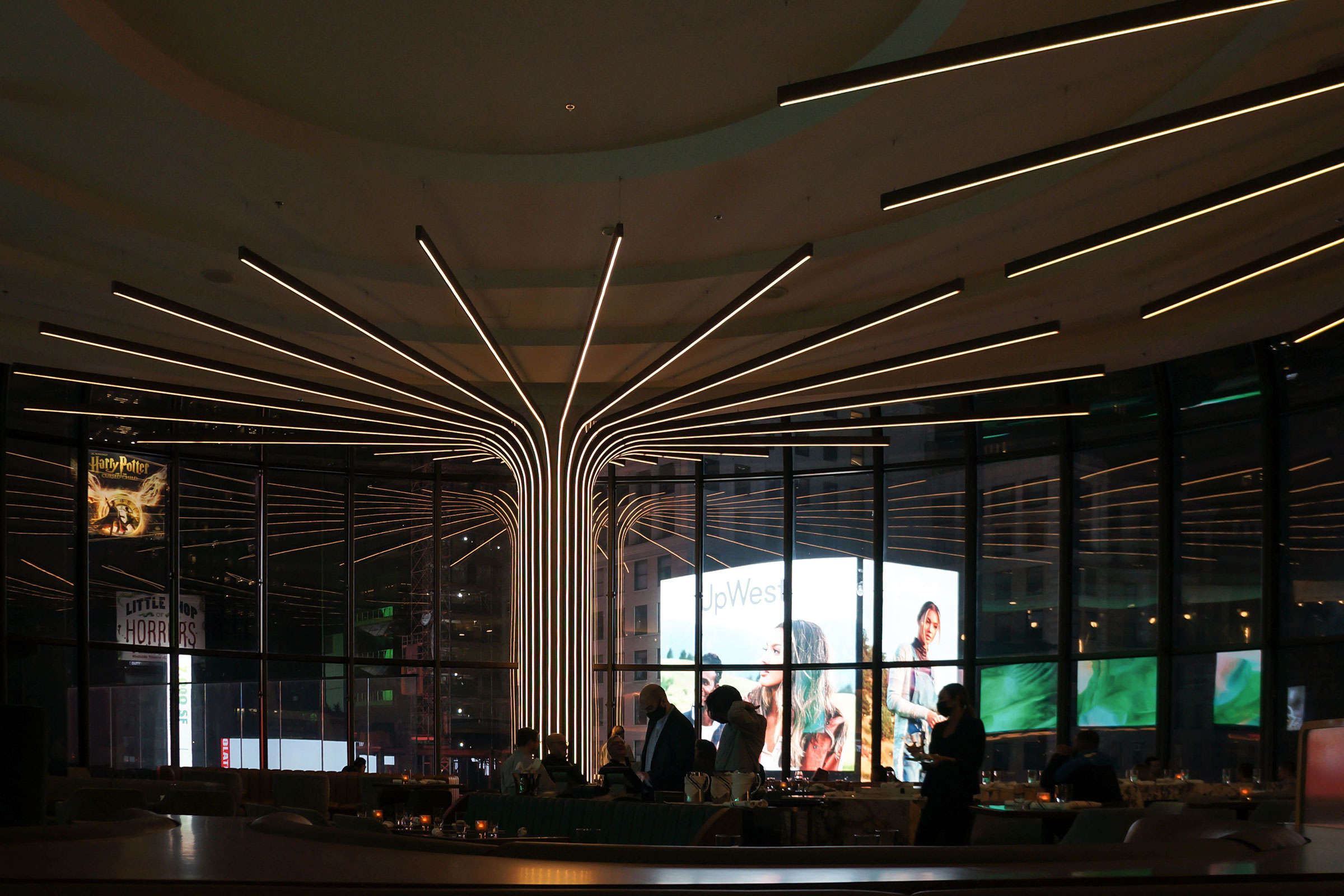
A captivating interior tree design with dramatic Trace Vertical linear LED from Tivoli Lighting brings elegance to the Broadway Lounge overlooking Times Square. Photo courtesy of Tivoli
Boasting more than 50 years of experience and innovation, Tivoli Lighting is an industry leader when it comes to energy-efficient lighting. Specializing in architectural and theater LED-based lighting solutions, Tivoli prioritizes performance, longevity, quality, and energy-efficiency in all of their products.
Tivoli’s Trace Vertical linear LED system, for example, is incredibly versatile and accommodates a range of creative uses without sacrificing efficiency in the process. “This linear LED system is designed for straight and curved interior and exterior applications is constructed using flexible SMD LEDs with zero voltage drop to provide reliable uniformity of light,” Robert Pullman, national sales manager at Tivoli, previously wrote for gb&dPRO. “Operating on 24 VDC, Trace Vertical linear LED is designed for up to 58-foot runs, consuming only 4.5 watts per foot while delivering up to 261 lumens with an 80+ CRI.”

